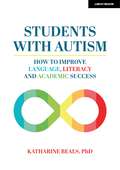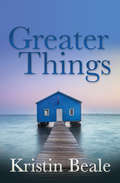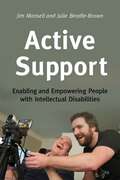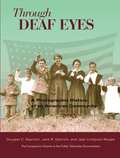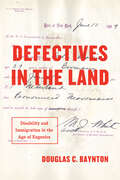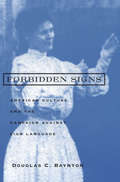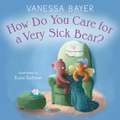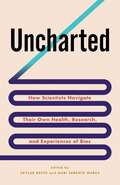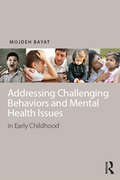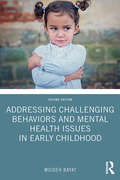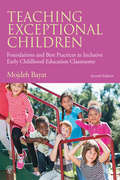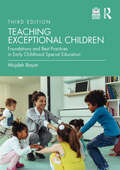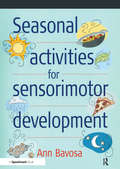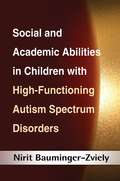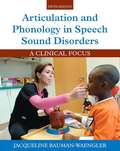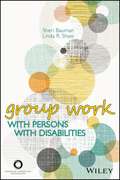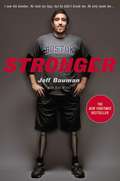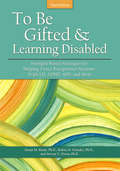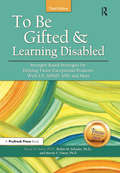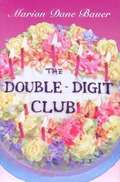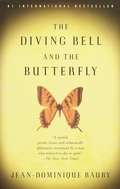- Table View
- List View
Students with Autism: How to improve language, literacy and academic success
by Katharine BealsBeals describes the root causes of the language and learning challenges in autism, their various academic consequences, and a variety of tools and strategies for addressing them. Drawing on what the most current evidence shows about the nature of autism and which therapies are most successful, the book discusses the implications for autism-friendly instruction in academic subjects, noting the ways in which today's classrooms come up short, and suggesting various adjustments that teachers can make.Instead of focusing on social and behavioral issues, general accommodations, and general ways to address learning difficulties, Beals zeros in on academics, on accommodations within specific academic subjects, and on techniques that target autism-specific deficits, situating the issue of educational access within the broader context of disability rights, neurodiversity, and debates about what disability rights and neurodiversity should encompass.Complete acceptance of individuals on the autism spectrum must include complete educational access. This means rethinking assumptions about autistic students, about how we teach expressive language, about how we teach reading comprehension, and about what and how we teach in the many K-12 classrooms attended by autistic students.
Greater Things: Triumph Over Adversity
by Kristin BealeKristin was thrown into a disability at the age of 14, and every day since then has been a struggle to overcome it. She has fought through the unavoidable physical stresses of her condition for over a decade and, even more, the heavy psychological burdens that follow closely behind. Greater Things is a raw perspective on everything from how people react differently to her situation, to learning how to navigate in and through an inaccessible world, to just trying to make the best of a crummy situation.
Active Support
by Julie Beadle-Brown Jim MansellActive Support is a proven model of care that enables and empowers people with intellectual disabilities to participate fully in all aspects of their lives. This evidence-based approach is particularly effective for working with people with more severe disabilities, and is of growing interest to those responsible for providing support and services. The authors provide a comprehensive overview of Active Support and how it can be used in practice, based on the theory and research underpinning the methods involved. They describe how to engage people with intellectual disabilities in meaningful activity as active participants, and look at the communication style needed to foster positive relationships between carers and the people they are supporting. Highlighting the main issues for those trying to put Active Support into practice, they explain what is needed on a day-to-day basis to support the implementation, improvement and maintenance of the approach, along with possible solutions for the difficulties they may encounter. Finally, they look at how to integrate Active Support with other person-centred approaches, drawing on examples from various organisations and individual case studies. The definitive text on Active Support, this book will be essential reading for anyone professionally concerned with the quality of life of people with intellectual disabilities, including psychologists, behaviour specialists, social workers, care managers, occupational therapists and inspectors and regulators of services, as well as families.
Through Deaf Eyes: A Photographic History of an American Community
by Douglas Baynton Jack Gannon Jean Lindquist BergeyHistory Through Deaf Eyes, an exhibition based on the lives of deaf people in the United States, toured the country from 2001 to 2006. During its twelve-city tour, more than 415,000 people visited the exhibit and learned of the struggles and triumphs of the Deaf community, a cultural, linguistic minority within the larger hearing population. The impetus for History Through Deaf Eyes came from Gallaudet University, the only university in the world founded specifically to provide higher education to deaf and hard of hearing people. Gallaudet is a cultural home to many deaf people. Studying the lives of deaf people illuminates not only a minority community but also the majority hearing population. Through the story of deaf America we learn much about our broader history. For both deaf and hearing readers, the history of the Deaf community offers a unique and fascinating perspective on the workings of human difference.
Defectives in the Land: Disability and Immigration in the Age of Eugenics
by Douglas C. BayntonImmigration history has largely focused on the restriction of immigrants by race and ethnicity, overlooking disability as a crucial factor in the crafting of the image of the "undesirable immigrant." Defectives in the Land, Douglas C. Baynton's groundbreaking new look at immigration and disability, aims to change this. In the late nineteenth and early twentieth centuries, Baynton explains, immigration restriction in the United States was primarily intended to keep people with disabilities--known as "defectives"--out of the country. The list of those included is long: the deaf, blind, epileptic, and mobility impaired; people with curved spines, hernias, flat or club feet, missing limbs, and short limbs; those unusually short or tall; people with intellectual or psychiatric disabilities; intersexuals; men of "poor physique" and men diagnosed with "feminism." Not only were disabled individuals excluded, but particular races and nationalities were also identified as undesirable based on their supposed susceptibility to mental, moral, and physical defects. In this transformative book, Baynton argues that early immigration laws were a cohesive whole--a decades-long effort to find an effective method of excluding people considered to be defective. This effort was one aspect of a national culture that was increasingly fixated on competition and efficiency, anxious about physical appearance and difference, and haunted by a fear of hereditary defect and the degeneration of the American race.
Forbidden Signs: American Culture And The Campaign Against Sign Language
by Douglas C. BayntonForbidden Signs explores American culture from the mid-nineteenth century to 1920 through the lens of one striking episode: the campaign led by Alexander Graham Bell and other prominent Americans to suppress the use of sign language among deaf people.<P><P> The ensuing debate over sign language invoked such fundamental questions as what distinguished Americans from non-Americans, civilized people from "savages," humans from animals, men from women, the natural from the unnatural, and the normal from the abnormal. An advocate of the return to sign language, Baynton found that although the grounds of the debate have shifted, educators still base decisions on many of the same metaphors and images that led to the misguided efforts to eradicate sign language.
How Do You Care for a Very Sick Bear?
by Vanessa BayerFrom debut children's author Vanessa Bayer and illustrator Rosie Butcher, How Do You Care for a Very Sick Bear? is a sweet picture book with advice for children—and adults—for dealing with a sick friend.You and your friend Bearare an excellent pair.But if your friend gets sick, And can’t do all the things that you two love to do…You may wonder--how do you care for a very sick Bear?When someone dear is dealing with illness, it's difficult to know what to do or say. The actor Vanessa Bayer experienced this firsthand when she was treated for childhood leukemia. In her first children's book, she offers gentle, reassuring advice that people of all ages will appreciate.
Uncharted: How Scientists Navigate Their Own Health, Research, and Experiences of Bias
by Skylar Bayer Gabriela Serrato MarksPeople with disabilities are underrepresented in STEM fields, and all too often, they face isolation and ableism in academia. Uncharted is a collection of powerful first-person stories by current and former scientists with disabilities or chronic conditions who have faced changes in their careers, including both successes and challenges, because of their health. It gives voice to common experiences that are frequently overlooked or left unspoken. These deeply personal accounts describe not only health challenges but also the joys, sorrows, humor, and wonder of science and scientists.With a breadth of perspectives on being disabled or chronically ill, these stories highlight the intersectionality of minoritized identities with the disability community. Uncharted features essays by contributors who are d/Deaf, blind, neurodivergent, wheelchair users, have experienced traumatic brain injuries, have blood sugar disorders, have rare medical diagnoses, or have received psychiatric diagnoses, among many others. In many cases, the scientific field is not fully accessible to them, and they frankly describe struggling as well as thriving alongside their conditions.This book serves as representation for scientists who have never felt comfortable disclosing their disability or who have never felt fully understood. The stories shared in this book seek to normalize medical conditions and disabilities in scientific culture, offering recommendations for how and why to improve access. Uncharted is vital and compelling reading for current and aspiring scientists who want to make their fields more inclusive and supportive for everyone.
Addressing Challenging Behaviors and Mental Health Issues in Early Childhood
by Mojdeh BayatA copublication with the Council for Exceptional Children (CEC), Addressing Challenging Behaviors and Mental Health Issues in Early Childhood focuses on research-based strategies for educators to address challenging behaviors of children during early childhood and elementary school years. Utilizing research from the fields of neuroscience, child development, child psychiatry, counselling and applied behavior analysis, the author suggests simple strategies for teachers to manage behaviors and promote mental health and resilience in children with challenging behaviors. Addressing Challenging Behaviors and Mental Health Issues in Early Childhood provides a framework for best practices which are empirically based and have been successfully utilized in the classroom. An appreciation of the deep understanding of culture as it affects curricular approaches, family engagement, and child growth and development is utilized throughout this comprehensive, multidisciplinary resource. Bayat references the most recent research in the field of child mental health and provides educational and intervention approaches that are appropriate for all children with and without disabilities.
Addressing Challenging Behaviors and Mental Health Issues in Early Childhood
by Mojdeh BayatNow in a fully updated second edition, this essential volume provides research-based strategies to help educators address challenging behaviors in early childhood and elementary years. Drawing on research and approaches from the fields of neuroscience, child development, child psychiatry, counseling, and applied behavior analysis, this text offers teachers simple strategies to manage behaviors and promote mental health and resilience in young children. Thoroughly updated to reflect new developments in neuroscience, trauma, and physical and mental health, this second edition also features an entirely new chapter on classroom approaches in child mental health, including the interaction of technology with challenging behaviors and mental health issues. Comprehensive, multidisciplinary, and culturally responsive, this critical resource provides new and experienced educators and coaches with educational and intervention approaches that are appropriate for all children, with and without disabilities.
Teaching Exceptional Children: Foundations and Best Practices in Inclusive Early Childhood Education Classrooms
by Mojdeh BayatTeaching Exceptional Children is an ideal textbook for introductory graduate and undergraduate courses on early childhood special education and teaching in inclusive classrooms. Bayat’s clear and accessible writing, a visually appealing design, and focused pedagogy in each chapter help make it possible to cover a significant amount of material. This powerful text identifies specific behavioral characteristics and presents theoretical information grounded in neuroscience and child development research for a wide range of disabilities. Research-based best practices for effectively working with children with various disabilities in inclusive classrooms are provided in each chapter. The second edition has been fully updated based on the DSM-5, and includes new sections on contemporary issues in inclusion of children with disabilities in early childhood classrooms, such as challenging behaviors, using technology, at-risk children, promoting mental health, and family issues. A robust pedagogical program, along with online resources for instructors and students, provides full support, including: Chapter Objectives and Key Terms help frame each chapter Discussion, Critical Thinking, Essay/Short Answer, and Review Questions at the beginning, throughout, and concluding chapters prompt students to fully engage with the material Homework/Field Assignments provide opportunities for students to apply their knowledge to real-world situations Real-Life Vignettes illustrate concepts in action Color Photos, Figures, and Tables clarify concepts in a visually engaging way Recommended Resources and References offer guidance for further study www.routledge.com/9781138802209 includes a link to an Instructor's Manual with ideas for assignments and projects, grading and assessment rubrics, and learning outcomes (see the e-Resource tab). A full companion website (www.routledge.com/cw/bayat) is under construction and will provide video and web links, discussion questions, test bank, PowerPoints, and a sample syllabus.
Teaching Exceptional Children: Foundations and Best Practices in Early Childhood Special Education
by Mojdeh BayatTeaching Exceptional Children is the ideal textbook for introductory graduate and undergraduate courses on early childhood special education and teaching in inclusive classrooms. Bayat’s clear and accessible writing, the text’s visually appealing design, and the focused pedagogy included in each chapter help make it possible for students and instructors to cover a significant amount of material. This powerful text identifies specific behavioral characteristics and presents theoretical information grounded in neuroscience and child development research for a wide range of disabilities. Chapters provide research-based best practices for effectively working with children with various disabilities in inclusive classrooms. This third edition has been fully updated with recent research and includes new sections on Universal Design for Learning, adaptations, technology, and common challenges in inclusive early childhood classrooms. This book is also accompanied by a robust collection of online resources for instructors and students, providing full support, including a Companion Website featuring an Instructor's Manual with additional ideas for assignments and projects, web and video links with reflection questions, a test bank, and lecture slides; and an eBook+ offering interactive links to videos, glossary terms, and more!
Seasonal Activities for Sensorimotor Development
by Ann BavosaThis book contains easy-to-use activities for therapists, educators and carers to provide fun and engaging sensorimotor groups for students with movement and sensory dysfunction. The activities span an entire year with a different main activity for each week. Themed by season, the activities can be linked to the school year and incorporated into the classroom. The activities promote socialisation, postural strengthening, improvement of gross and fine motor skills, and self-regulation of the body. Comprehensive instructions on how to run a group are included, as well as benefits and adaptations for severely affected individuals and wheelchair users. There are sensory-regulating warm-up appetizers to increase body awareness and prepare the students for movement; main course activities to strengthen fine and gross motor skills; and cool-down desserts to regulate the body and assimilate benefits gained during group activities. The activities are suitable for use with any school-age students, including those without movement difficulties, but are especially beneficial for students with mild to moderate motor disabilities, who exhibit increased difficulty functioning in a group setting.
Social and Academic Abilities in Children with High-Functioning Autism Spectrum Disorders
by Nirit Bauminger-ZvielyA uniquely comprehensive resource for practitioners, this research-based book addresses both the social-emotional and cognitive-academic challenges faced by children and adolescents with high-functioning autism spectrum disorders (HFASD). The author traces these kids' developmental trajectories and explores their distinct combination of strengths and needs. Effective school-based interventions for overcoming the social isolation and learning difficulties often associated with HFASD are reviewed in depth. Appendices include concise descriptions of more than 50 relevant assessment tools, plus a detailed, practical outline of the author's empirically supported social intervention model. E-book purchasers can download and print the tables from the Appendices at the companion Web page.
Articulation and Phonology In Speech Sound Disorders: A Clinical Focus
by Jacqueline Bauman-WaenglerThis comprehensive book ties strong academic foundations directly to their clinical application for speech/language therapists working with speech sound disorders. Each chapter presents tools to help readers bridge the gap between theoretical issues and clinical applications by presenting Clinical Applications, Clinical Exercises, Case Studies, and a section called Think Critically, which asks students to further apply specific clinical concepts. Test Yourself multiple choice questions appear at the end of each chapter and are ideal for review and assessment of the knowledge presented in the chapters, and Further Readings allow readers to continue to expand their knowledge. The new Fifth Edition of Articulation and Phonology in Speech Sound Disorders reflects the current use of the term "speech sound disorder," an umbrella term for what was previously noted as articulation- and phonemic-based disorders.
Group Work With Persons With Disabilities
by Sheri Bauman Linda R. ShawThis one-of-a-kind manual provides direction for leading groups of people with disabilities or groups that have members with disabilities. Viewing disability as a single aspect of a multifaceted person, Drs. Bauman and Shaw share their insight and expertise and emphasize practical skill building and training for facilitating task, psychoeducational, counseling, family, and psychotherapy groups across various settings. Topics examined in Part I include common themes in groups that focus on disability; various group formats, including groups using technological platforms; issues of diversity that exist simultaneously with ability; group composition; ethical concerns; and training considerations and logistical accommodations. Part II focuses on group counseling with clients experiencing sensory, psychiatric, cognitive, and physical disabilities as well as chronic medical conditions. A list of resources, support information, and group exercises completes the book. *Requests for digital versions from the ACA can be found on wiley.com. *To request print copies, please visit the ACA website here. *Reproduction requests for material from books published by ACA should be directed to permissions@counseling.org
Stronger
by Jeff Bauman Bret WitterWhen Jeff Bauman woke up on Tuesday, April 16th, 2013 in the Boston Medical Center, groggy from a series of lifesaving surgeries and missing his legs, the first thing he did was try to speak. When he realized he couldn't, he asked for a pad and paper and wrote down seven words: "Saw the guy. Looked right at me," setting off one of the biggest manhunts in the country's history. Just thirty hours before, Jeff had been at the finish line of the 2013 Boston Marathon cheering on his girlfriend, Erin, when the first bomb went off at his feet. As he was rushed to the hospital, he realized he was severely injured and that he might die, but he didn't know that a photograph of him in a wheelchair was circulating throughout the world, making him the human face of the Boston Marathon bombing victims, or that what he'd seen would give the Boston police their most important breakthrough. Up until the marathon, Jeff had been a normal 27-year-old guy, looking forward to moving in with Erin and starting the next phase of their lives together. But when his life was turned upside down in ways he could never have fathomed, Jeff did not give up. Instead he faced his new circumstances with grace, humor, and a sense of purpose: he was determined, no matter what, to walk again. In STRONGER, Jeff describes the chaos and terror of the bombing itself and the ongoing FBI investigation in which he was a key witness. He takes us inside his grueling rehabilitation, and discusses his attempt to reconcile the world's admiration with his own guilt and frustration. And he tells of the courage of his fellow survivors. Brave, compassionate, and emotionally compelling, Jeff Bauman's story is not just his, but ours as well. It proves that the terrorists accomplished nothing with their act of cowardice and shows the entire world what Boston Strong really means.
To Be Gifted and Learning Disabled 3E: Strength-Based Strategies for Helping Twice-Exceptional Students With LD, ADHD
by Susan Baum Steven Owen Robin SchaderTo Be Gifted and Learning Disabled is one of the most popular resources available on identifying and meeting the needs of gifted and learning disabled (GLD) youngsters. Part I discusses the patterns of accomplishments and failures that many GLD students present and provides important information about the development of two traditionally separate fields-giftedness and learning disabilities-as well as identification and diagnosis issues. Part II explores the contemporary psychological theory and research that guides educational applications for GLD students. Part III offers practical strategies for teaching GLD students and helping them plan and explore options for their future. This revised and expanded edition includes three new chapters on self-regulation, developing comprehensive IEPs for GLD students, and the roles parents and counselors can play in meeting the social and emotional needs of GLD students. Thoroughly researched and filled with case studies, practical suggestions and techniques for working with GLD students, useful resources, and much more, To Be Gifted and Learning Disabled is a resource anyone who works or lives with a child who has both startling talents and disabling weaknesses should have.
To Be Gifted and Learning Disabled: Strength-Based Strategies for Helping Twice-Exceptional Students With LD, ADHD, ASD, and More
by Susan M. Baum Robin M. Schader Steven V. OwenTo Be Gifted and Learning Disabled is one of the most popular resources available on identifying and meeting the needs of twice-exceptional students. This updated third edition provides a comprehensive look at the complex world of students with remarkable gifts, talents, and interests, who simultaneously face learning, attention, or social challenges from LD, ADHD, ASD, and other disorders. Through case studies and years of research, the authors present a rationale for using a strength-based, talent-focused approach to meeting the needs of this special population. From a thorough description of twice-exceptionality and the unique learning patterns of these students, to strategies for identification, comprehensive programming, talent development, and instructional strategies, this book explores the distinguishing strengths (yellows) and complex challenges (blues) that these students face. In painting, green is a mix of yellows and blues. Because of their individual characteristics, twice-exceptional students come in a remarkable range of greens. 2018 NAGC Book of the Year Award Winner
Deaf-Blind Interpreting Workbook: Student Readings and Worksheets
by Mary Bauer Karen Chriest Stueland Jackie Engler-Morris Janie Neal Jelica Nuccio Cynthia WallaceThis workbook was put together to cover basic Deaf-Blind interpreting techniques. Over the past years, the Seattle Deaf-Blind Community has shaped this class and the workbook has evolved.
The Double-Digit Club
by Marion Dane BauerNine-year-old Sarah is excited about summer vacation, but she faces unexpected crises when her best friend Paige becomes old enough to join a local girls' clique, and when she makes choices which affect her relationship with an elderly blind neighbor.
Dexterity
by Douglas BauerAs a teenager in a small town in upstate New York, Ramona is infatuated with handsome, domineering Ed King, but after their marriage she quickly loses her illusions. When her hand is severed in an accident she feels she can no longer care for their infant son. She flees from Ed and the town, leaving her son behind. In alternating chapters the novel follows Ramona's flight and reveals the effect of her disappearance on Ed.
Inclusive Classrooms: Video Cases on CD-ROM Activity and Learning Guide to accompany Exceptional Lives Special Education in Today's Schools
by Anne M. Bauer Stephen D. KroegerSkills and knowledge for creating inclusive classrooms.
Come Fall
by A. C. E. BauerLu Zimmer's best friend moved away last summer. Salman Page is the new kid in school. Blos Pease takes everything literally. Three kids who are on the fringe of the middle school social order find each other and warily begin to bond, but suddenly things start going wrong. Salman becomes the object of the school bully's torment, and Lu's pregnant mother has some unexpected complications. Is something conspiring against them? In fact, through no fault of their own, Salman and Lu have become pawns in a game of jealous one-upmanship between Oberon and Titania, the king and queen of Faery, with the mischievous Puck trying to keep the peace. Taken from Titania's mention of a foundling in Shakespeare'sA Midsummer Night's Dream, A. C. E. Bauer spins an original tale about magical intervention in the least magical of settings: a public middle school. From the Hardcover edition.
The Diving Bell and the Butterfly: A Memoir of Life in Death
by Jean-Dominique Bauby Jeremy LeggattIn December 1995, Jean-Dominique Bauby, the forty-three-year-old editor of French Elle, suffered a massive stroke that left him completely and permanently paralyzed, a victim of "locked-in syndrome." Where once he had been renowned for his gregariousness and wit, Bauby now found himself imprisoned in an inert body, able to communicate only by blinking his left eye. The miracle is that in doing so he was able to compose this stunningly eloquent memoir, which was published two days before Bauby's death in 1996 and went on to become a number-one bestseller across Europe. The second miracle is that is less a record of affliction than it is a celebration of the liberating power of consciousness. In a voice that is by turns wistful and mischievous, angry and sardonic, Bauby tells us what it is like to spend a day with his children; to imagine lying in bed beside his lover; to conjure up the flavor of delectable meals even as he is fed by tube. Most of all, this triumphant book allows us to follow the flight of an indomitable spirit and to share its exultation at its own survival. (Taken from the back cover)
